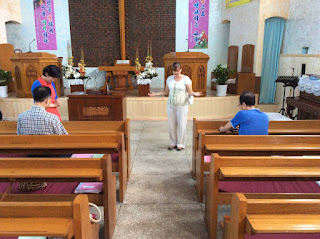Today we flew from Gwangju to Jeju island. Jeju is the largest island of Korea and is located directly south of the peninsula.
In the late afternoon we visited the April 3rd Peace Memorial. The memorial stood in remembrance of the thousands of victims of government oppression killed on Jeju Island. Starting in 1948 the newly divided north and south of Korea were scheduled to each hold elections, thus formalizing their division into two countries by outside governments. The people of Jeju strongly resisted being divided and protested the elections. The South Korean government, supported by the United States, sent troops to quell the resistance. In a three year period nearly 30,000 residents of Jeju were killed including women, children and elderly. The South Korean government, after the 1948 elections, subsequently passed a law referred to something like "patriotism and treason" which declared that any public discussion of the deaths on Jeju Island would be punished by prison or death, thus effectively silencing the story of what happened on Jeju for years.
It wasn't until nearly 50 years after the incidents occurred that the truth came to light and that a movement was made to seek transparency. The Peace Memorial standing as a reminder of government repression against ones own people.
You can read more at: https://en.wikipedia.org/wiki/Jeju_uprising
Jeju Island itself is known for water, wind, and women. Korean's believe in Yin and Yang, always balancing each other out. Jeju Island reportedly had too much of a feminine presence (it was a partially matriarchal society- see comments on women diver's below). To rectify all of that female influence phallic stone status are located all over the island.
Being an island surrounded by the abundance of the sea, Jeju has a long history of sea diving. Divers would bring up precious foods and items for commerce including abalone, shellfish and octupus. By the 18th century many of Jeju's most accomplished divers were women, who thus became the primary bread-winners for their families. Female babies were celbrated and women's families were known to pay doweries to men. Women divers were a staple in Jeju's history until modern time when technical advances in seafood collection have altered their way of life. More can be found at: https://en.wikipedia.org/wiki/Haenyeo
July 26th 2016
Today was a strictly fun day. We went horseback riding, had a great sashimi lunch overlooking Jeju island's most famous outcropping, took a dip in the ocean and went to bed early!
July 27th 2016
Today we drove to the sight of the naval base on Jeju Island. The base is extremely controversial because of it's impact on Jeju's delicate coral reefs and because of the soverignty of Korea being host to several major U.S. military bases.
Information about the base and the protests surrounding it's installation can be found here:
https://en.wikipedia.org/wiki/Jeju_Naval_Base
Protesters were gathered in front of the gates the day we visited. One of the signs translated that the Sewol Ferry, which was known to have capsized due to excessive cargo, was carrying supplies including construction materials for the new navy base. This information added to the already complex and tragic story of the Sewol Ferry disaster.
Jonathan and I had an evening flight back to Seoul and settled in for our last day.
July 28th 2016
Today was our last full day in Seoul. We spent the morning doing some last minute shopping, packing, and sightseeing. We returned to the PROK office to say farewell to the ecumenical office staff and to the General Secretary. During the trip I've been keeping a running list of potential follow ups between the UCC / DOC and the PROK Rev. Min Heui and I reviewed the list and made plans for her trip stateside in the fall.
It's worth mentioning that while we were in Korea both Republican and Democratic national conventions took place in the U.S. and several Korean's expressed concerns over U.S. presidential elections.
Taking advantage of the last moments of daylight we did a whirlwind tour of the King's Palace in downtown Seoul.
We ended the day with dinner with members of the Seoul South Presbytery who have recently signed a partnership agreement with the Hawaii Conference of the United Church of Christ.
We said farewell to Rev. Min Heui, thanked her for her extravagant hospitality, leadership and ecumenical vision. She showed us where to catch the airport bus in the morning and we were off to our next adventure.
God, we are grateful for new opportunities, for your every unfolding story and for the chance to engage with others. We give thanks for safe travel, new friends, and the faithful witness to the life and ministry of your son Jesus and show through people and places throughout the world. Amen.



















































